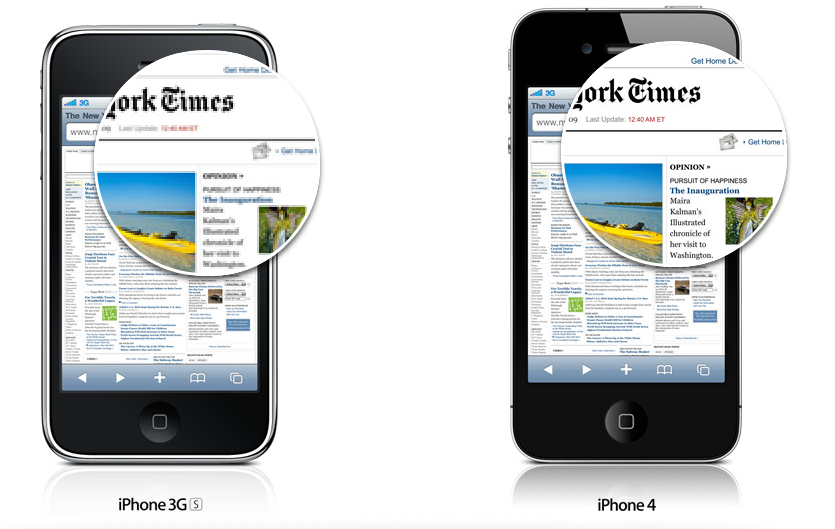
Apple states that the iPhone 4's 3.5-inch display has 614,400 78 micrometer-wide pixels which gives us a density of 326 ppi (pixels per inch). Apple claims this will give the iPhone 4 a, "pixel density so high that the human eye is unable to distinguish individual pixels" (at 12 inches). So, is this just a bit of marketing magic or does the iPhone 4 display really venture beyond the limits of the human eye?
Raymond Soneira, the president of DisplayMate, a company which does analysis of screens gave these statistics: the angular resolution of the retina is 0.6 arc minutes per pixel, which he derived from the angular measure of 50 cycles per degree with each cycle being a line pair -- two pixels.
Using this model if you hold an iPhone 4 at 8 inches you would be viewing 716 ppi, at 12 inches it would be 477 ppi and if you hold an iPhone 4 further away at 18 inches it would then fall to 318 ppi. From this Raymond Soneira deduced that the iPhone has significantly lower resolution than the retina. He even went further stating that you would need a resolution higher than the retina to deliver a image that looks perfect.
William H.A. Beaudot, Ph.D, a researcher from McGill University, states in his profile that "My research is aimed at understanding how visual information is integrated across space, time and its attributes by the human visual system, as well as modeling specific anatomical circuits and interactions between the visual cortical areas involved in these processes." You got all that? Me neither... but he seems to know a lot about the visual system.
Beaudot states that 300 pixels per inch is related to standard visual acuity of 20/20 vision. This means that a normal eye can discriminate between two points by 1 arc minute (1/60 deg). 1 arc minute seen from a distance of 12 inches to a dot size of about 89 micrometer or pixel density of 286.5 dpi. Thus, since the iPhones retina display has a pixel density or 326 dpi, it is 14 % better than we would have at 12 inches with 20/20 vision. Using these facts Beaudot feels that Apples claims are accurate.
He went on to state that the optimal viewing distance quoted by Jobs is 12-inches but Beaudot feels that this may be too close. He measured that the most comfortable distance from his eye to the iPhone 3GS was 18 inches which would make Apple's numbers even better.
So what does seem to be agreed upon is that from 12 to 18 inches the image will be pretty close to if not better than visual acuity.The 326 dpi of the iPhone 4 is also better than magazine print which is only 300 dpi. If you are one of the few who hold your iPhone within 5 inches of your face you will probably be able to see pixels. Either way the iPhone 4 will have a display unmatched in the smartphone market.
Master your iPhone in minutes
iMore offers spot-on advice and guidance from our team of experts, with decades of Apple device experience to lean on. Learn more with iMore!
What do you think about this, I would love to know your opinion.
[The Loop, Gadget Lab, Popular Mechanics via Gizmodo]
Senior Editor at iMore and a practicing therapist specializing in stress and anxiety. She speaks everywhere from conferences to corporations, co-host of Vector and Isometric podcasts, follow her on Twitter @Georgia_Dow and check out her series at anxiety-videos.com.
